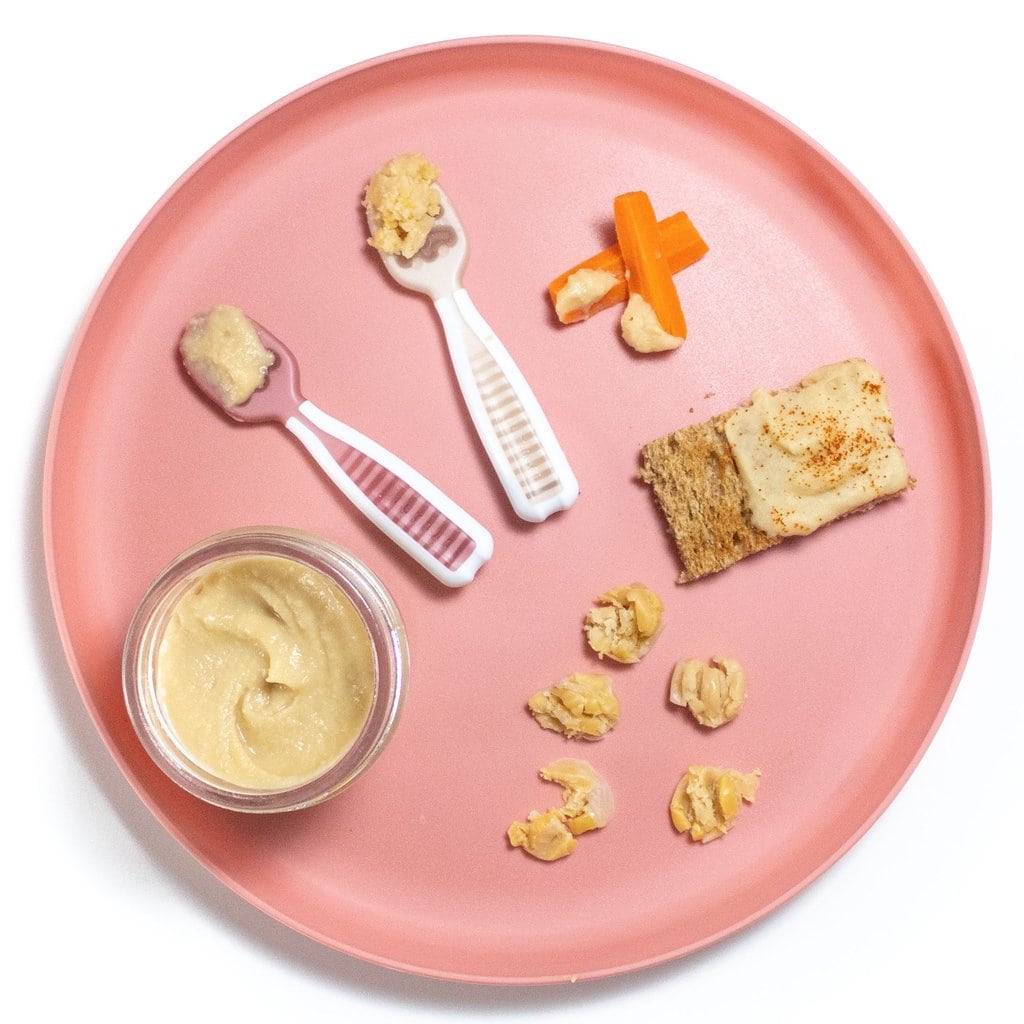In this guide, learn how to serve chickpeas to your baby – for baby-led weaning or as a puree. Chickpeas are a great source of protein, fiber, carbohydrates, and other essential nutrients, making them a great first food for babies 6 months and up. Serve them as a baby food puree, as a solid for the finger food stage, or for baby-led weaning.
Medically reviewed and cowritten by Jamie Johnson, Registered Dietitian Nutritionist (RDN), and Lauren Braaten, Pediatric Occupational Therapist (OT).
Chickpea Baby Food
If there’s one food that packs a powerful amount of nutrition into a little package, it’s definitely the chickpea. Not only are chickpeas a great source of protein, carbohydrates and fiber, but they’re also full of other essential nutrients like folate, vitamin B6, iron, and zinc.
Sounds like something that would be good for your growing baby, right?
But how exactly do you serve chickpeas to baby? Don’t worry, we’ve got you covered. In this guide, we’ll cover all the information you need in order to safely serve chickpeas to baby for baby-led weaning or traditional (spoon) feeding. You’ll learn about the nutritional benefits, FAQs, helpful tools, and expert feeding tips.
First time making homemade baby food? Then, I would suggest that you start by reading my very in-depth Guide on how to Make Homemade Baby Food – which goes over all the important information such as the best cooking tools to have on hand, safe storage, how to know when baby is ready for solids, how to introduce purees, the best first foods for baby, and more! If you are doing Baby-Led Weaning, then be sure to check out my Complete Guide to Baby-Led Weaning – which covers what exactly is baby-led weaning, to every parent’s concern of baby-led weaning and choking, this guide goes over it all. I will also share how to know when baby is ready for BLW, the top 10 best first foods, a helpful sample blw feeding schedule, helpful tools to have on hand, and much much more!
Reasons to Love Chickpeas for Baby
- Great for baby-led weaning – 6+ months
- Also great for the finger food stage – 9+ months
- Full of essential nutrients for baby
- Different ways for baby to eat – spoon-fed or self-feed
- Easy to make – minimal prep work required
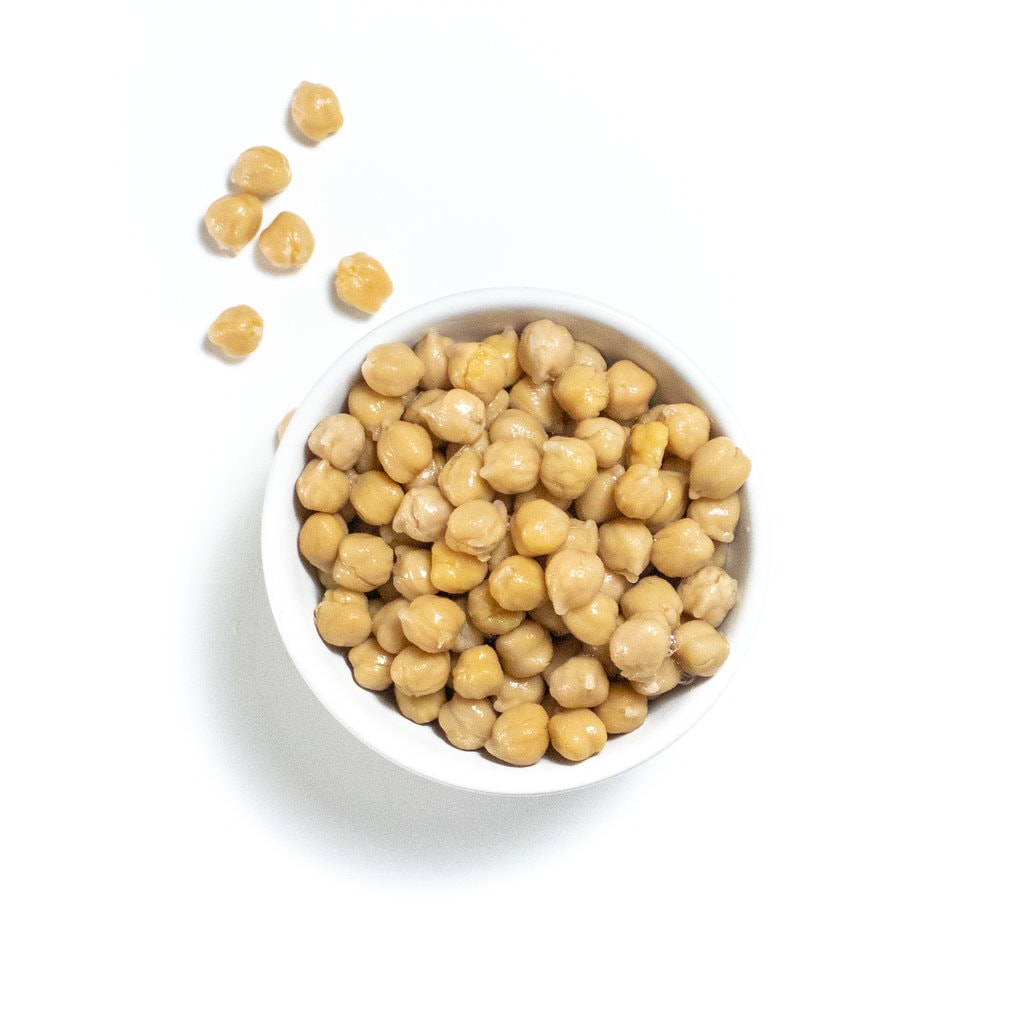
Health Benefits of Chickpeas
Chickpeas are chock full of all sorts of important nutrients for your baby, making them an excellent food to serve when baby starts eating solid foods, whether mashed or pureed in hummus.
- Chickpeas are an excellent source of fiber, making them a great choice to help digestion.
- They’re also a good source of protein, necessary for growth and development.
- Chickpeas have one of the most important nutrients for babies-iron, and vitamin C, which helps to absorb iron.
How to Pick Chickpeas
You can buy canned chickpeas or dried chickpeas in bulk when making them for your baby. Here’s what to look for with either option:
Canned
Look for canned chickpeas with “no sodium added” or low sodium. Conventional and organic are both good options, but make sure to rinse them well before cooking. Canned chickpeas are great if you’re short on time in the kitchen.
Dried
Dried chickpeas are usually bought in bulk and can save you some money. Again, conventional or organic are pretty equal choices. If you have a little more time (and planning) for meal prep, dried chickpeas are often touted as the better-tasting option regarding texture and flavor. You’ll need to soak them in water for several hours or overnight, and they’ll need a longer cooking time compared to canned chickpeas.
Types of Beans for Baby
Really all types of beans are highly nutritious and great for your baby, just make sure you are serving them in an age-appropriate way. Here’s a list of some of the most common beans:
- Black beans
- Cannellini beans
- Pinto beans
- Lima beans
- Kidney beans
- Great Northern beans
- Navy beans
- Edamame
How to Cook Chickpeas
There are all sorts of ways you can prepare chickpeas, from warming to roasting to blending.
From a Can
Canned chickpeas do not have to be cooked but if you’d like to, just rinse and drain them, and heat them up until warmed through, either on the stove or in the microwave.
Dried
For dried chickpeas, soaking them overnight will reduce the cooking time. Make sure you sort through the chickpeas to remove any unwanted debris and rinse them. Put one cup of chickpeas in a pan with 3 cups of water, or broth for more flavor, and bring to a boil. Then let simmer for 60-90 minutes or until they reach your desired consistency.
Spices to Add
If you want savory chickpeas, you can add garlic, cumin, chili powder, onion powder, paprika, turmeric, red pepper flakes, or Italian seasoning to your chickpeas.
If you’re in the mood for sweet chickpeas, add a little cinnamon or cloves.
Frequently Asked Questions
Chickpeas can absolutely be baby’s first food, just make sure you serve it in an age-appropriate way to reduce the choking risk.
Chickpeas are not one of the most common food allergens in the U.S., but as with any food, be aware of any signs of an allergic reaction when introducing it.
Yes, chickpeas are a choking hazard due to their round shape, and are hard when raw. Make sure to serve it in an age-appropriate way to reduce the choking risk.
No, in fact, due to their high fiber content, they can help alleviate constipation.
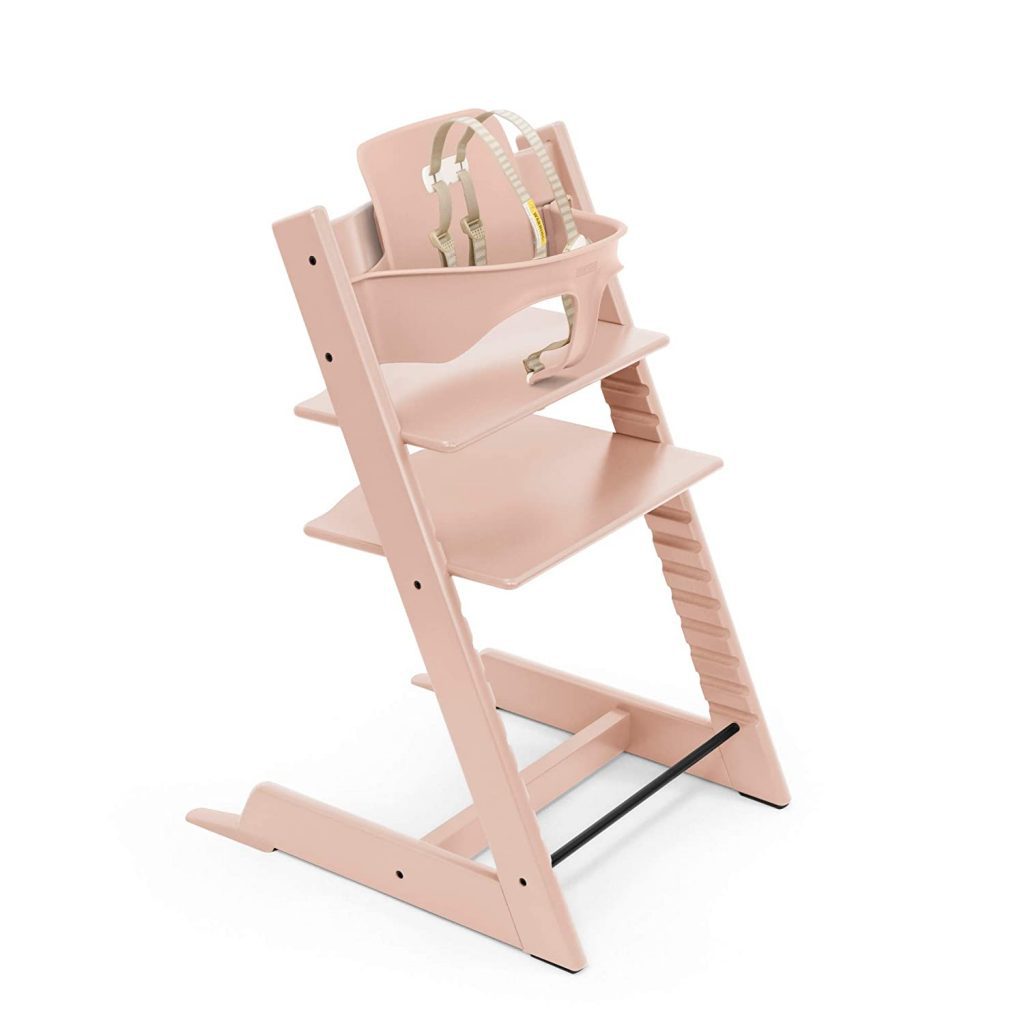
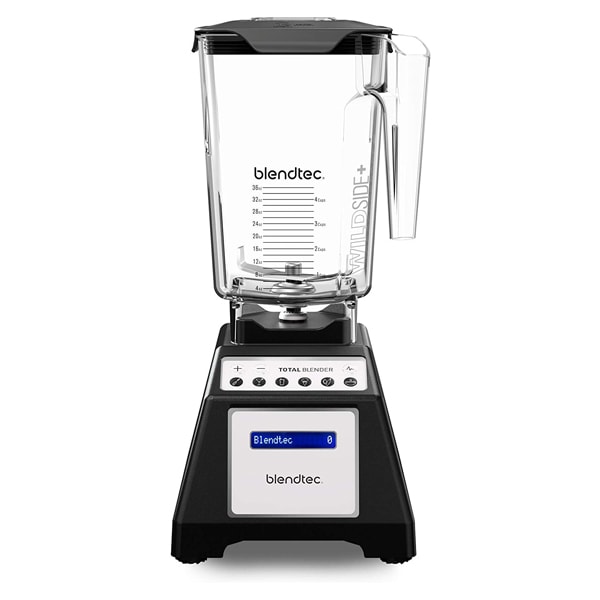
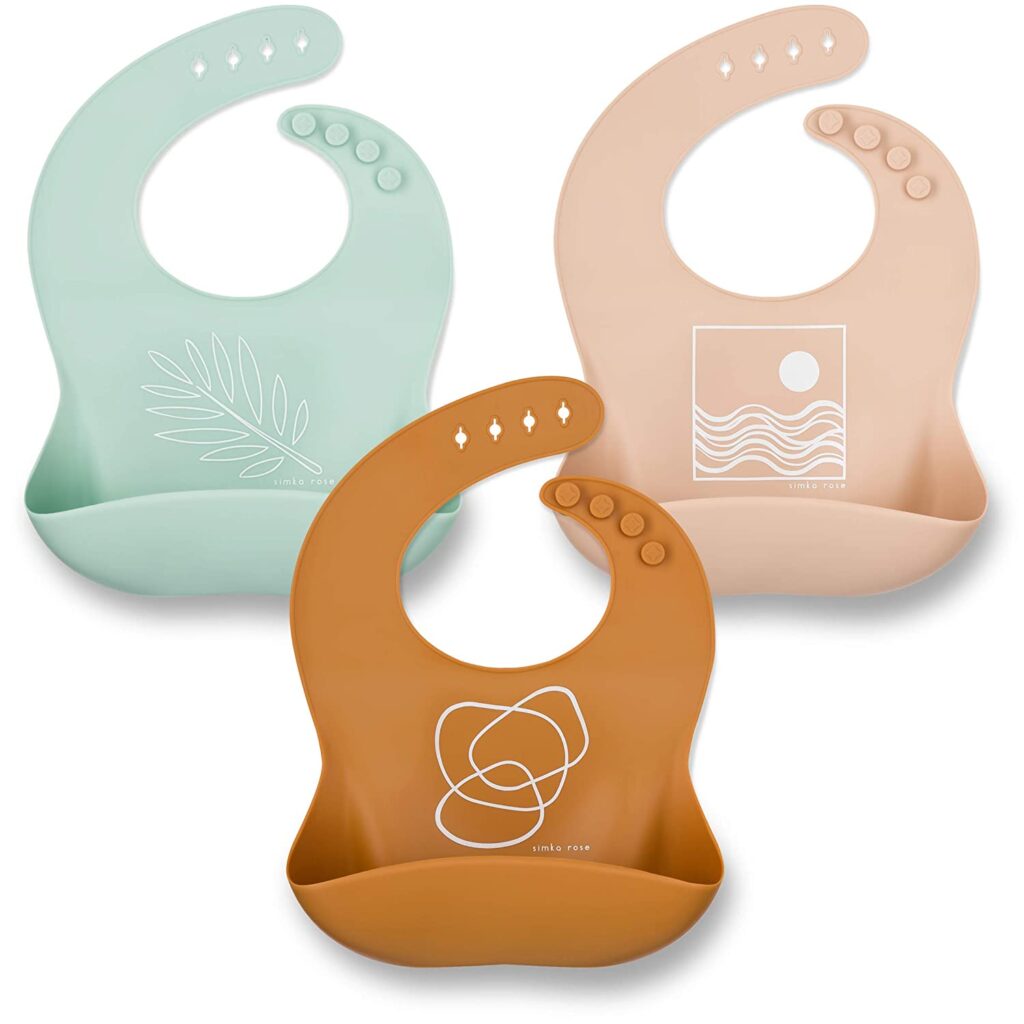
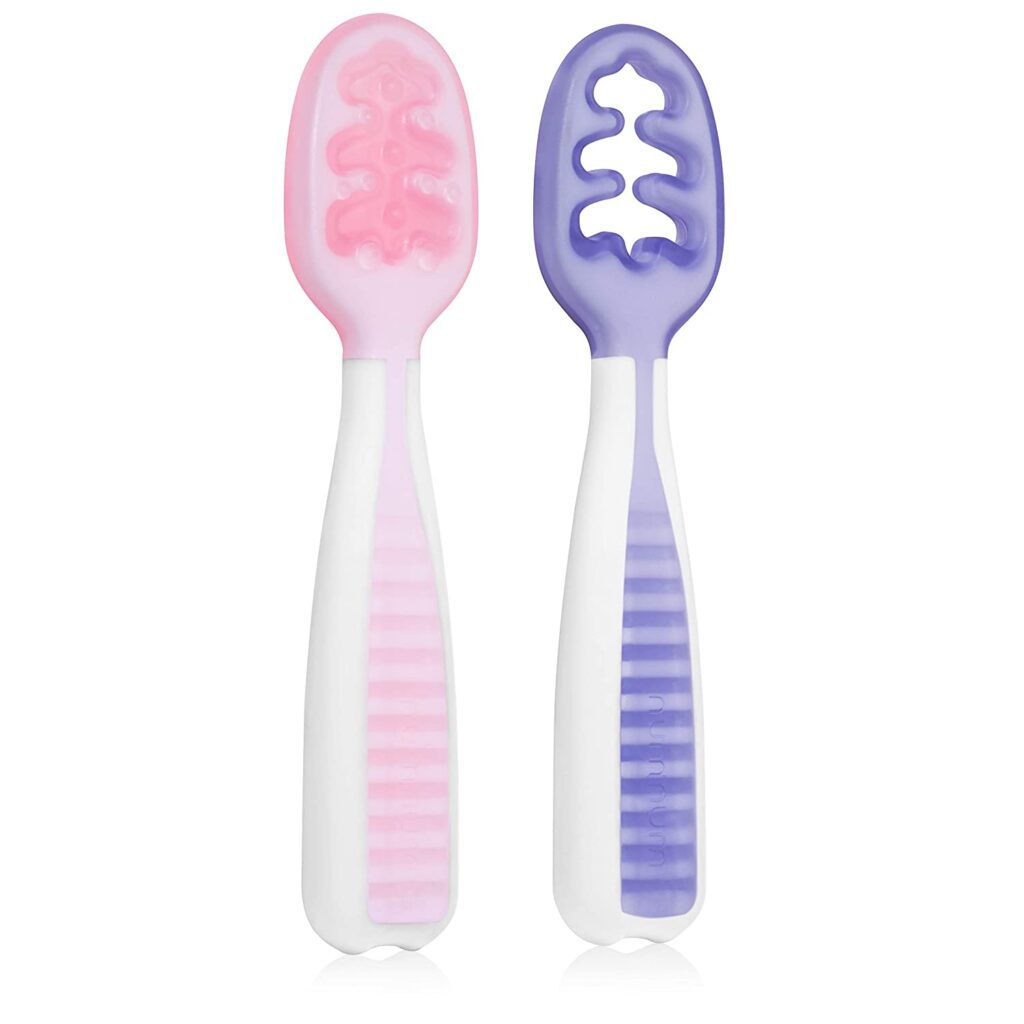
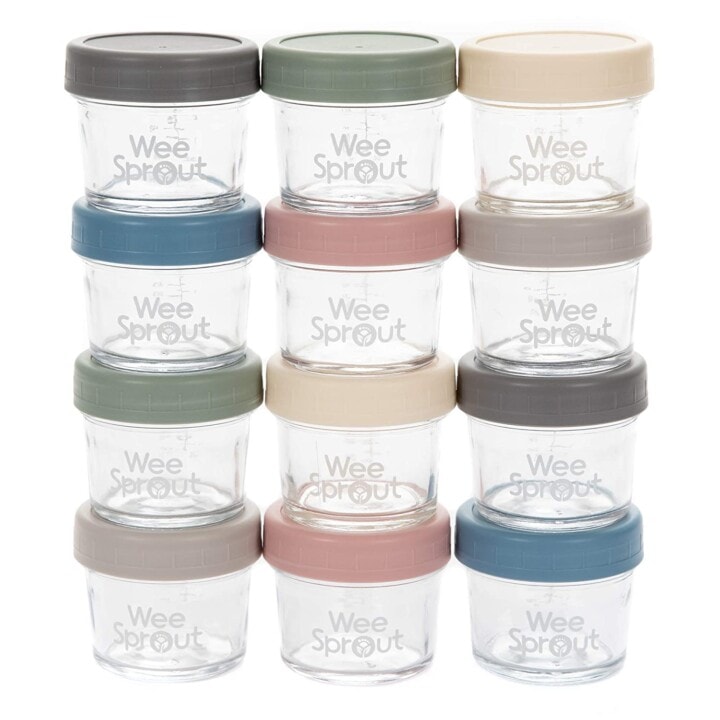
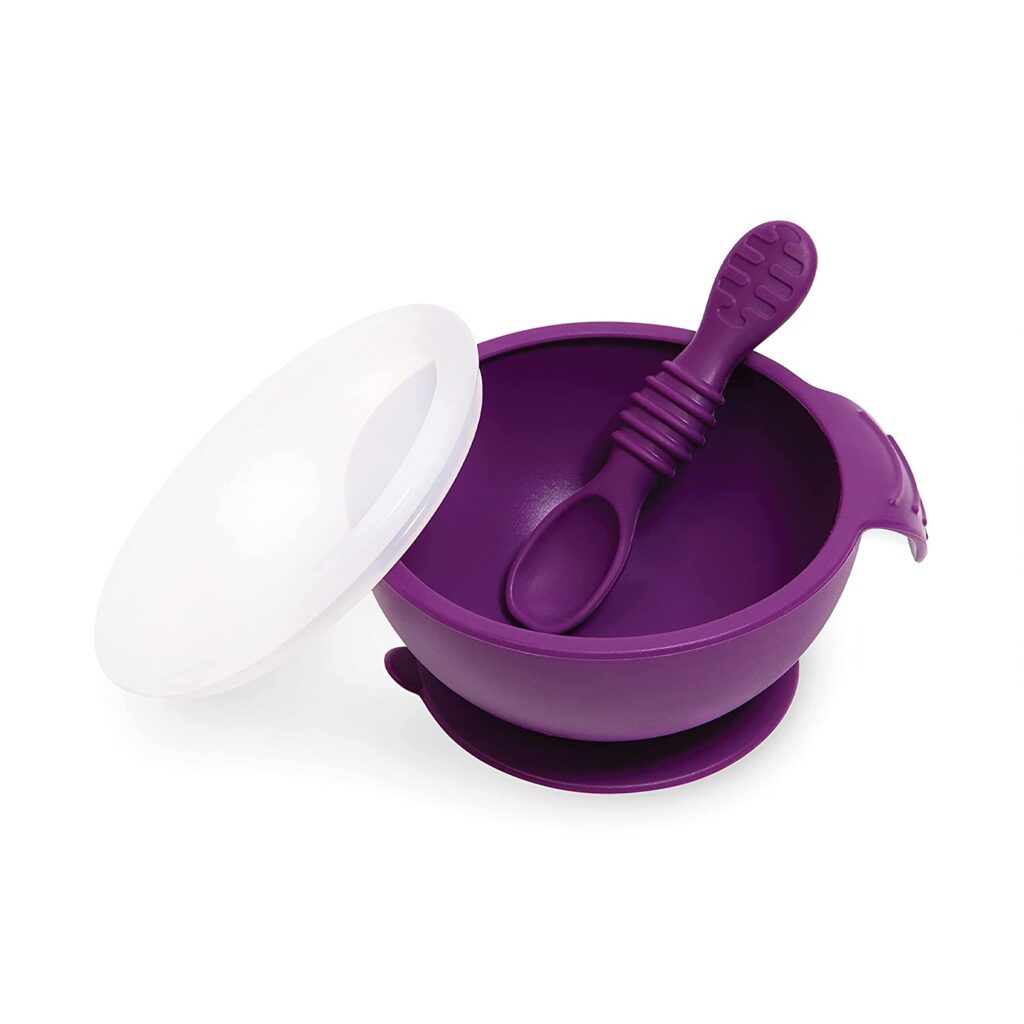
Helpful Tools
Here are some products that will help with making and serving chickpeas to your baby even easier! To find even more products that I love, make sure to check out my online shop.
Chickpea Puree
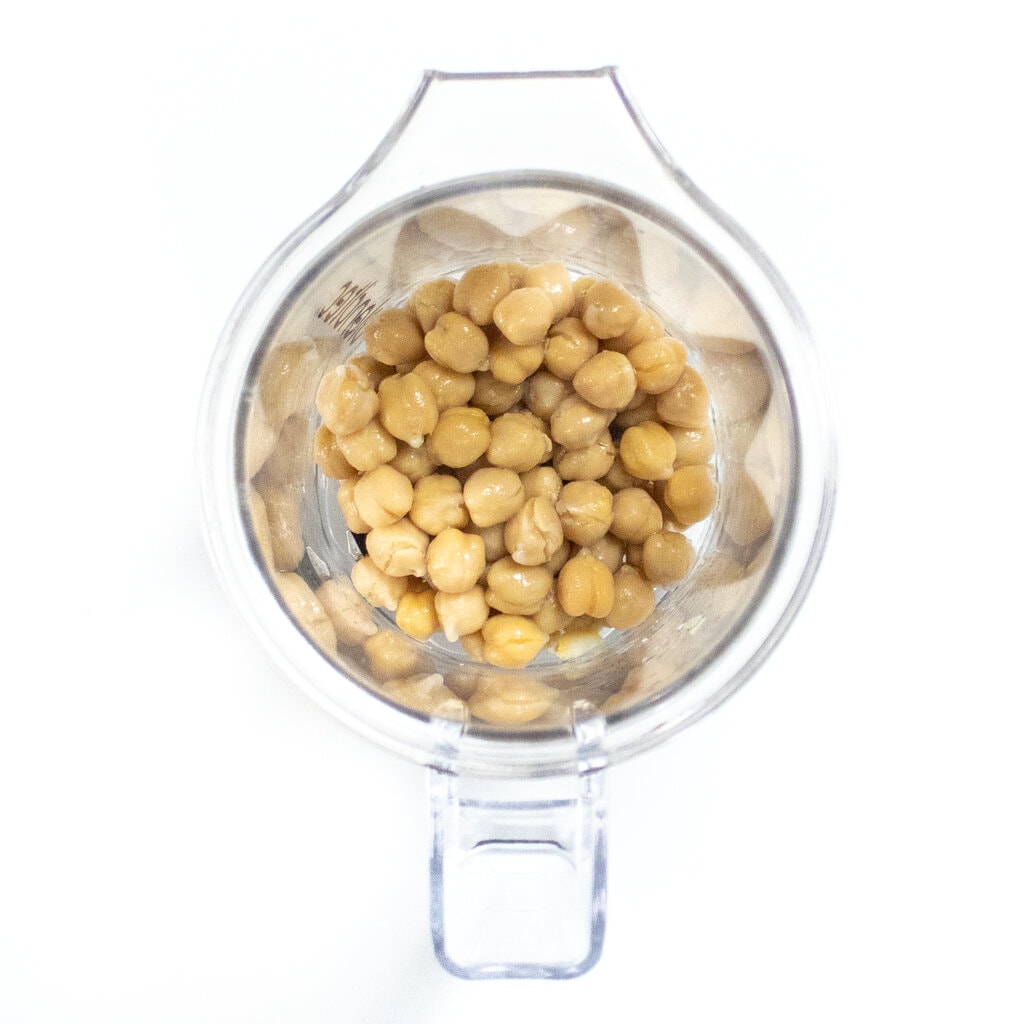
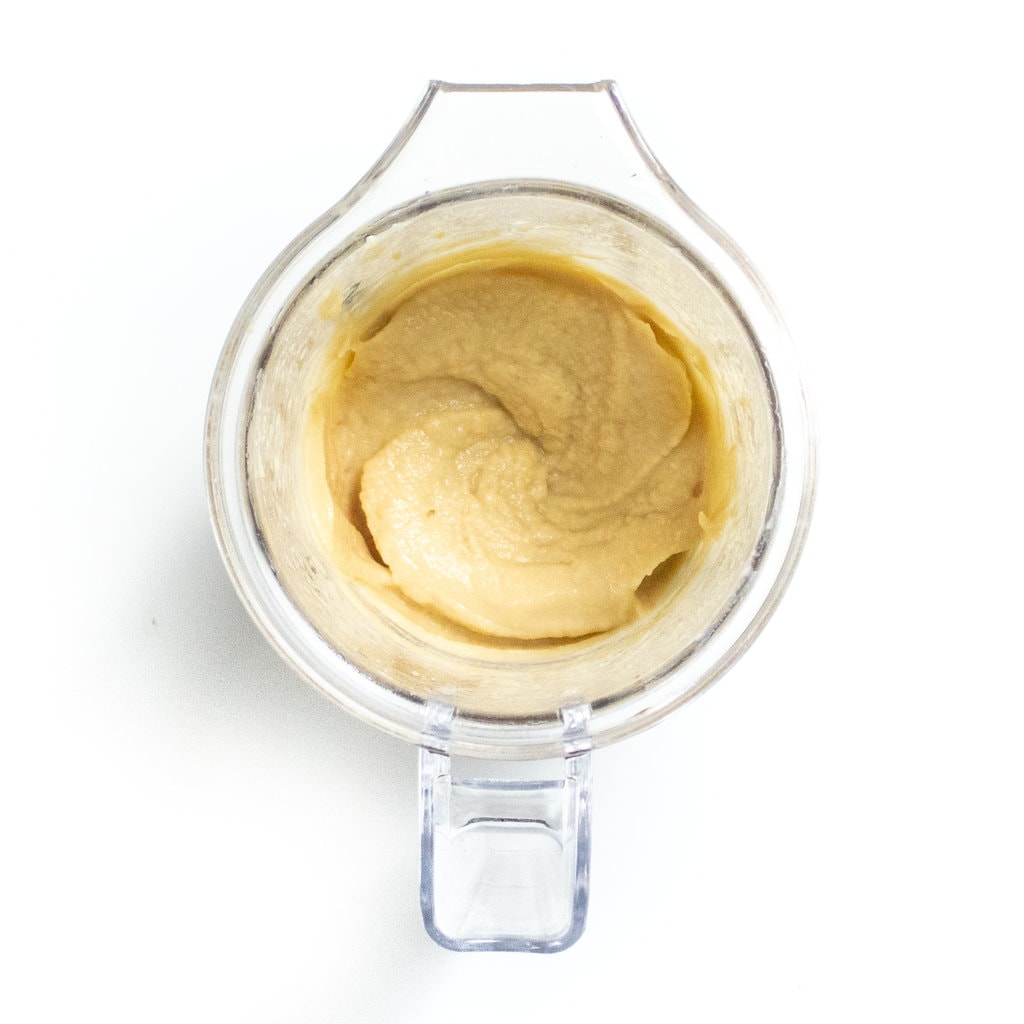
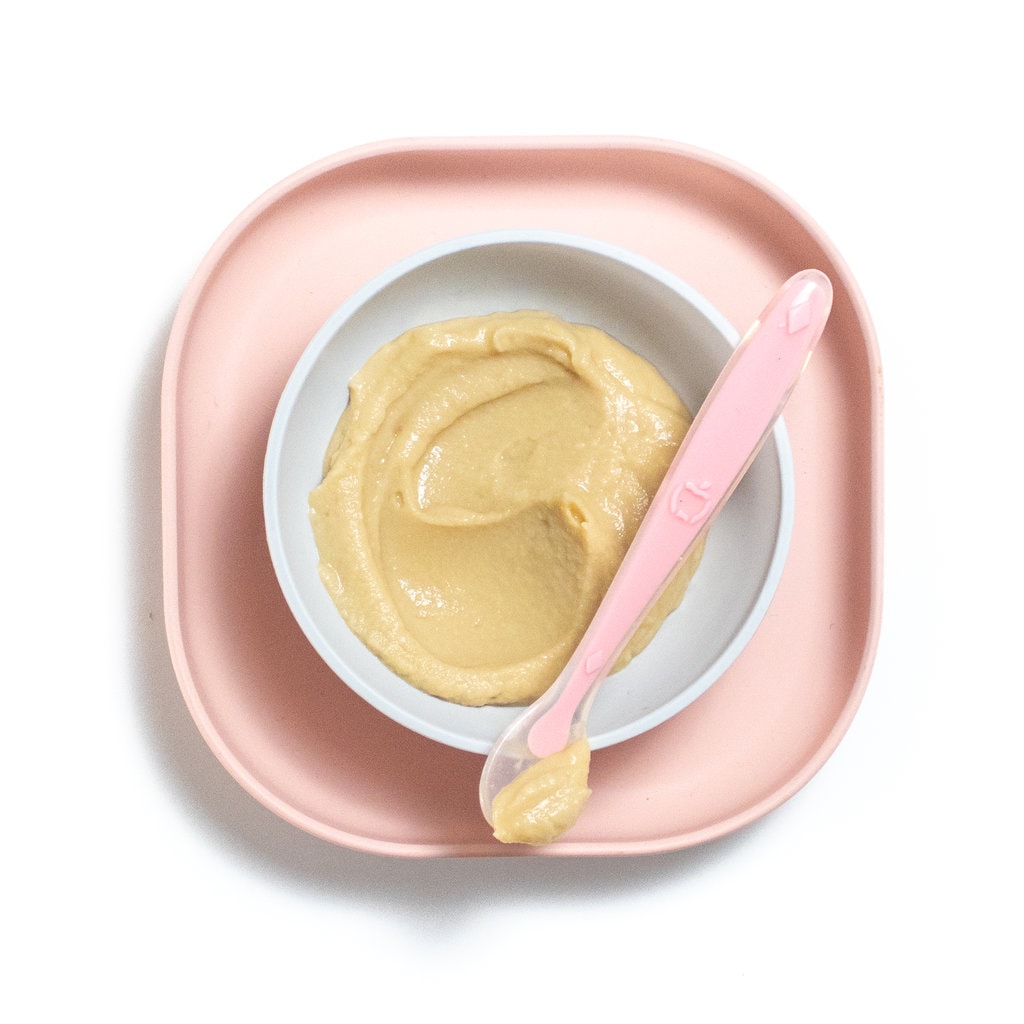
Rinse your chickpeas well in a mesh strainer, whether using canned or pre-soaked. Place chickpeas in a blender or food processor and blend to desired consistency, adding 1 tablespoon of water at a time as needed to thin puree. You can also add 1 teaspoon of fresh squeezed lemon juice or other spices.
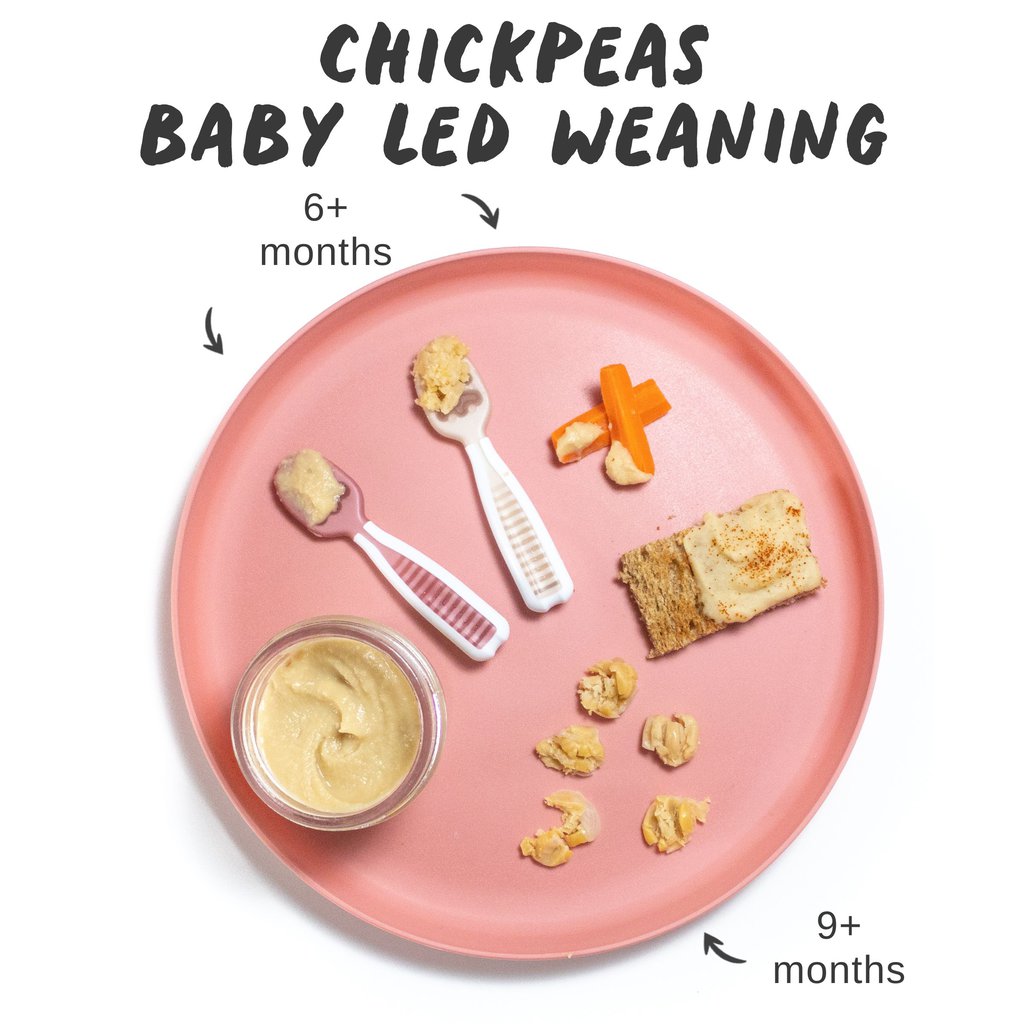
Chickpea for Baby-Led Weaning
Chickpeas are a great food for your baby to self-feed, whether for baby-led weaning, which happens around 6 months of age, or during the finger foods stage at 9 months.
Mashed or Hummus – 6+ months: great for babies 6+ months or just starting on solid foods. It’s best to start your baby with mashed chickpeas that baby can scoop or in hummus (make sure sesame is not an allergen) and spread on toast, teething crackers, or soft veggies so baby can self-feed.
Flattened- 9+ months: Fully cooked and flattened chickpeas will allow your baby to practice using their pincer grasp, which is developing at this age. You can still offer hummus and mashed chickpeas, too.
Storage Instructions
Chickpea Puree
Refrigerator
You can store it in an airtight container in the fridge for up to 4 days.
Freezer
This puree can be frozen for up to 4 months.
- Spoon puree into a freezer storage container – do not overfill.
- Place the lid on the storage container or cover it with a piece of saran wrap and label it with the date and recipe name.
- Place the tray into the freezer and let freeze completely – preferably overnight.
- Pop out the baby food cubes and place them in a zip-lock baggie or stasher bag – don’t forget to re-label the baggie or stasher bag for future reference.
Baby-Led Weaning
You can store cooked chickpeas in an air-tight container in the fridge for 3-5 days.
Combination Purees
While Chickpea Baby Food is great by itself, it’s also super easy to mix and match with other nutrient-dense baby food purees. Give these fun flavor combos a try!
More Favorite Recipes
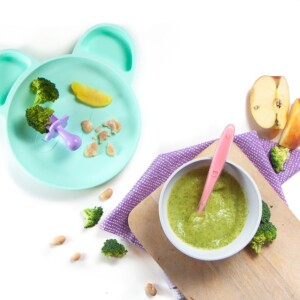
Broccoli, Apple + White Beans Baby Food Meal
This broccoli, apple and white beans recipe can either be made as a puree for your littlest or served as baby led weaning. Made with just 3 simple ingredients, the plant based puree, or the finger food, is all made in one pot. The puree is great for make ahead freezer baby meals.
Get the recipe
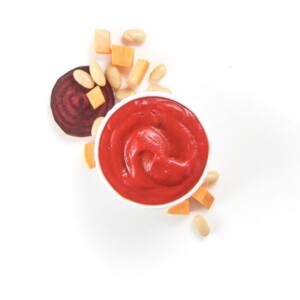
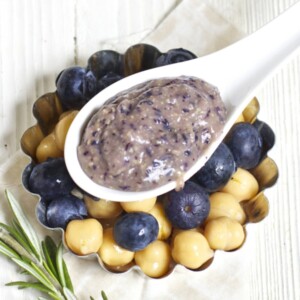
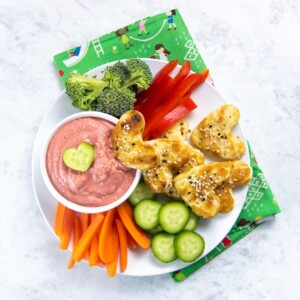
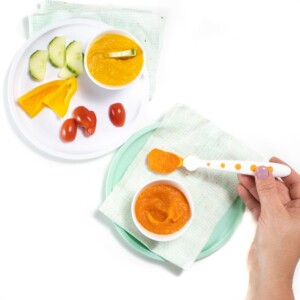
Expert Feeding Tips
- If serving hummus with sesame as an ingredient, make sure sesame is not an allergen before serving.
- If using canned chickpeas, look for “no sodium added” cans.
- Soaking dried chickpeas also helps reduce gas and bloating so if your baby seems gassy after eating them, try soaking them the next time.
- Vitamin C helps increase the body’s ability to absorb iron from plant sources – serve chickpeas with other foods that are high in vitamin C, including bell peppers, broccoli, strawberries, or kiwi.
- 1 cup canned chickpeas (or cooked from dried) rinsed
Chickpea for Baby-Led Weaning
Storage: you can store the chickpea puree in an air-tight container in the fridge for up to 4 days or in the freezer for up to 4 months. You can store the chickpeas in an air-tight container in the fridge for up to 4 days.
Spices/Herbs:
If you want savory chickpeas, you can add garlic, cumin, chili powder, onion powder, paprika, turmeric, red pepper flakes, or Italian seasoning to your chickpeas.
If you’re in the mood for sweet chickpeas, add a little cinnamon or cloves.
Chickpea for Baby-Led Weaning
Mashed or Hummus – 6+ months: great for babies 6+ months or just starting on solid foods. It’s best to start your baby with mashed chickpeas that baby can scoop or in hummus (make sure sesame is not an allergen) and spread on toast, teething crackers, or soft veggies so baby can self-feed.
Flattened- 9+ months: Fully cooked and flattened chickpeas will allow your baby to practice using their pincer grasp, which is developing at this age. You can still offer hummus and mashed chickpeas, too.


